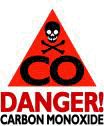Carbon Monoxide Detectors

What is Carbon Monoxide?
Carbon Monoxide (CO) is an invisible, odorless gas. It is a common by-product of incomplete combustion, produced when fossil fuels (like oil, gas, or wood) burn. Because you can’t see, taste or smell it, carbon monoxide can KILL you before you know it’s there. Exposure to lower levels over time can make you sick.
Why is Carbon Monoxide dangerous?
Carbon monoxide robs you of what you need most – Oxygen, which is carried to your cells and tissue by the hemoglobin in your blood. If you inhale even small amounts of CO, it quickly bonds with hemoglobin and displaces oxygen. This produces a toxic compound in your blood called carboxyhemoglobin (COHb).
Carboxyhemoglobin produces flu-like symptoms, such as headaches, fatigue, dizzy spells, confusion, and irritability. Since symptoms are similar to the flu, carbon monoxide poisoning can be misdiagnosed. As levels of COHb rise, victims suffer vomiting, loss of consciousness, and eventually brain damage or death.
Where does Carbon Monoxide come from?
Gas or oil appliances like a furnace, clothes dryer, range, oven, water heater, wood burning stove or fueled space heaters can produce CO. When appliances malfunction, for example; a furnace heat exchanger can crack; vents can clog, kerosene heater is not properly vented or debris may block a chimney or flue causing the gas to seep into the home.
How can I protect against carbon monoxide poisoning? (CO Detectors)
The International Association of Fire Chiefs recommends UL listed CO alarms with an audible warning signal are installed on every level of the home and one, in or near each sleeping quarters.
Have your appliances, chimneys and flues inspected and cleaned by a qualified technician at least once a year or as recommended by the manufacturer.
Always ensure your home is properly ventilated. When exhaust fans run they lower the indoor air pressure. If the indoor air pressure is lower than the outdoor air pressure, the airflow in chimneys and vents can reverse, pulling exhaust-containing CO back into the home.
How does the Fire Department check for Carbon Monoxide?
The Fire Department has special detectors that monitor parts per million (PPM) of the atmosphere at any given location. These detectors can detect even small amounts of CO. If a problem is found, ventilation and mitigation of the hazard will be performed.
If you think you have a problem contact the Tuftonboro Fire Department immediately.














